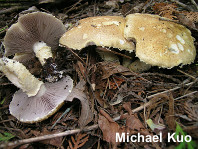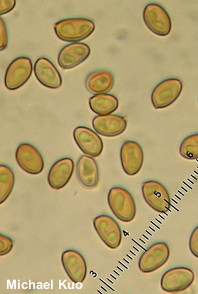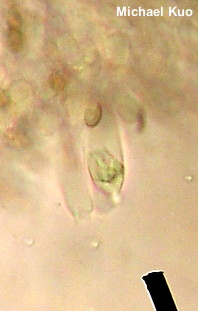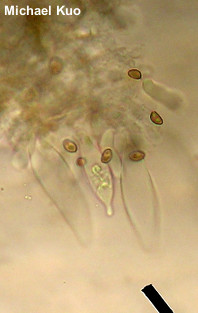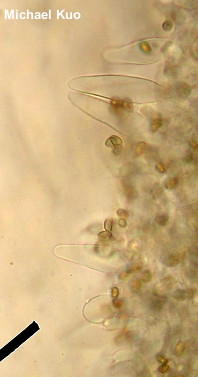| Major Groups > Gilled Mushrooms > Dark-Spored > Stropharioid Mushrooms > Stropharia kauffmanii |

|
Stropharia kauffmanii [ Basidiomycota > Agaricales > Strophariaceae > Stropharia. . . ] by Michael Kuo Among the larger species of Stropharia, Stropharia kauffmanii is recognized by its yellowish, dry, innately scaly cap. The scales are not superficial veil remnants and thus cannot be easily removed. The stem is also scaly, though it can become more or less bald in older specimens. Stropharia kauffmanii was originally described from the Pacific Northwest, but has since been reported from the Southwest, Colorado, and the Great Lakes region. Alexander Smith, the original author of the species, presciently wrote in his 1975 Field Guide to Western Mushrooms: "It is very likely more common and widespread than present records indicate." Description: Ecology: Saprobic; growing alone, scattered, or gregariously on litter and woody debris in hardwood and conifer forests; summer and fall; distributed from the Pacific Northwest to the Southwest and eastward to at least Québec (apparently "northern and montane"). The illustrated and described collection is from Michigan. Cap: 6–15 cm; convex, becoming broadly convex to nearly flat; dry; yellow to brownish yellow; covered with innate, fibrillose scales; the margin sometimes adorned with partial veil remnants. Gills: Attached to the stem, often by means of a notch; close; short-gills frequent; pale at first, becoming purplish gray to purple-black. Stem: 6–10 cm long; 1–2.5 cm thick; equal, or with a slightly tapered base; tough; dry; with a fragile whitish ring or ring zone; prominently scaly, at least when young; basal mycelium white; base with mycelial threads. Flesh: White; unchanging when sliced. Odor and Taste: Odor slightly fragrant; taste not distinctive. Spore Print: Dark purple-brown to blackish. Chemical Reactions: KOH on cap surface pinkish orange. Microscopic Features: Spores 6–8 x 4–5 µmm; ellipsoid; with a very tiny pore; smooth; golden to golden brown in KOH. Pleuro-chrysocystidia 25–40 x 5–12.5 µmm; lageniform; apex mucronate, subcapitate, or merely cylindric; thin-walled; smooth; hyaline in KOH; inclusion small, globular, and golden-refractive. Cheilocystidia dimorphic: 1) chrysocystidia similar to pleurocystidia; and 2) leptocystidia 50–75 x 10–15 µmm, widely fusiform, smooth, thin-walled, hyaline in KOH. Pileipellis a cutis with occasional aggregations of upright, bundled elements; golden in KOH; elements 2.5–5 µmm wide, smooth. REFERENCES: Smith, 1941. (Smith, 1975; Stamets, 1978; Smith, Smith & Weber, 1979; Arora, 1986; States, 1990; McNeil, 2006; Miller & Miller, 2006; Kuo & Methven, 2014; Evenson, 2015; Siegel & Schwarz, 2016.) Herb. Kuo 09130701. This site contains no information about the edibility or toxicity of mushrooms. |
© MushroomExpert.Com |
|
Cite this page as: Kuo, M. (2017, January). Stropharia kauffmanii. Retrieved from the MushroomExpert.Com Web site: http://www.mushroomexpert.com/stropharia_kauffmanii.html |
